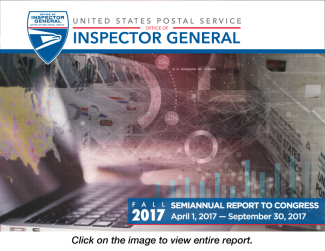Fall 2017 Semiannual Report to Congress
The Office of Inspector General is tasked with ensuring efficiency, accountability, and integrity in the U.S. Postal Service. We also have the distinct mission of helping to maintain confidence in the mail and postal system, as well as to improve the Postal Service's bottom line. We use audits and investigations to help protect the integrity of the Postal Service. Our Semiannual Report to Congress presents a snapshot of the work we did to fulfill our mission for the six-month period ending Spetember 30, 2017. Our dynamic report format provides readers with easy access to facts and information, as well as succinct summaries of the work by area. Links are provided to the full reports featured in this report, as well as to the appendices.
A MESSAGE FROM THE ACTING INSPECTOR GENERAL
Inspector General (OIG) has worked to fulfill its mission of ensuring efficiency, accountability, and integrity in the U.S. Postal Service. Our work also helps to maintain confidence in the postal system and to improve the Postal Service’s bottom line.
This report, submitted pursuant to the Inspector General Act, outlines our work and activities for the six-month period ending September 30, 2017. During this period, we issued 105 audit reports, management advisories, PARIS risk models and white papers, and the Postal Service accepted 83 percent of our recommendations. We completed 1,584 investigations that led to 430 arrests and more than $68 million in fines, restitutions, and recoveries, $21 million of which was turned over to the Postal Service.
The Postal Service faces a number of strategic challenges as it adapts to a rapidly changing communications market. Those challenges, which include financial and business constraints, workplace relations, service performance, and cybersecurity issues, also guide our work. In this report, you will find synopses of audit reports and white papers that focus on those areas, as well as work requested by congressional stakeholders.
Adding to the Postal Service’s challenges is the lack of a fully functioning Board of Governors, which by law is to be made up of the postmaster general, deputy postmaster general, and nine independent governors appointed by the president and approved by the Senate. Since December 2016, the governing body has been without any independent governors, raising questions about long-term strategic planning around rates, products, services, and the overall direction of the organization.
As new challenges emerge, the lack of governors is doubly concerning. One such challenge is the use of the mail to move illicit narcotics, to include opioids. Multiple agencies and private organizations have been mobilized to identify strategies to address the broader problem of opioid addiction in our country, and coordination at the highest levels is critical.
The use of the postal infrastructure to facilitate movement of narcotics appears to be increasing, and traffickers are getting more sophisticated in avoiding detection. We have stepped up our data analytics work in this area as we have recognized that the best way to identify drug trafficking activities using the mail is through analytics. We are currently testing analytics tools that focus on suspicious parcels and carrier routes, “over-labeling” of narcotics parcels by employees, and identifying high-risk opioid parcels in the mail stream using international advance electronic data.
I look forward to working with all stakeholders as we address these challenges and any others that lie ahead. With the support of postal management and Congress, the OIG will continue to play a key role in maintaining the integrity and accountability of America’s Postal Service, its revenue and assets, and its employees.

